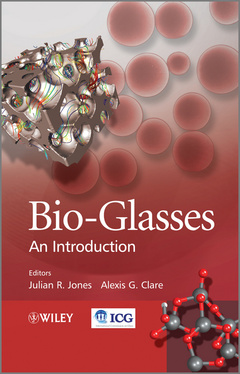Description
Bio-Glasses
An Introduction
Coordinators: Jones Julian, Clare Alexis
Language: English
Subject for Bio-Glasses:
272 p. · 15.5x23.6 cm · Hardback
Description
/li>Contents
/li>Biography
/li>
This new work is dedicated to glasses and their variants which can be used as biomaterials to repair diseased and damaged tissues. Bio-glasses are superior to other biomaterials in many applications, such as healing bone by signaling stem cells to become bone cells.
Key features:
- First book on biomaterials to focus on bio-glasses
- Edited by a leading authority on bio-glasses trained by one of its inventors, Dr Larry Hench
- Supported by the International Commission on Glass (ICG)
- Authored by members of the ICG Biomedical Glass Committee, with the goal of creating a seamless textbook
- Written in an accessible style to facilitate rapid absorption of information
- Covers all types of glasses, their properties and applications, and demonstrates how glass is an attractive improvement to current procedures
- Of interest to the biomedical as well as the materials science community.
The book covers all types of glasses: traditional glasses, bioactive glasses, sol-gel glasses, phosphate glasses, glass-ceramics, composites and hybrids. Alongside discussion on how bio-glasses are made, their properties, and the reasons for their use, the authors also cover their applications in dentistry, bone regeneration and tissue engineering and cancer treatment. Its solid guidance describes the steps needed to take a new material from concept to clinic, covering the essentials of patenting, scale-up, quality assurance and FDA approval.
List of Contributors xi
Foreword xiii
Preface xvii
1 The Unique Nature of Glass 1
Alexis G. Clare
1.1 What is Glass? 1
1.2 Making Glass 5
1.3 Homogeneity and Phase Separation 8
1.4 Forming 9
1.5 Glasses that are not "Melted" 10
1.6 Exotic Glass 11
1.7 Summary 11
2 Melt-Derived Bioactive Glass 13
Matthew D. O'Donnell
2.1 Bioglass 13
2.2 Network Connectivity and Bioactivity 18
2.3 Alternative Bioactive Glass Compositions 19
2.4 In Vitro Studies 22
2.5 In Vivo Studies and Commercial Products 22
3 Sol–Gel Derived Glasses for Medicine 29
Julian R. Jones
3.1 Introduction 29
3.2 Why Use the Sol–Gel Process? 30
3.3 Sol–Gel Process Principles 31
3.4 Steps in a Typical Sol–Gel Process 32
3.5 Evolution of Nanoporosity 36
3.6 Making Sol–Gel Monoliths 37
3.7 Making Particles 38
3.8 Sol–Gel Derived Bioactive Glasses 40
3.9 Summary 42
4 Phosphate Glasses 45
Delia S. Brauer
4.1 Introduction 45
4.2 Making Phosphate Glasses 46
4.3 Phosphate Glass Structure 46
4.4 Temperature Behaviour and Crystallisation 50
4.5 Phosphate Glass Dissolution 56
4.6 Cell Compatibility of Glasses 59
4.7 Phosphate Glass Fibres and Composites 60
4.8 Applications 62
4.9 Summary 63
5 The Structure of Bioactive Glasses and Their Surfaces 67
Alastair N. Cormack
5.1 Structure of Glasses 67
5.2 Structure of Bioactive Glasses 70
5.3 Computer Modeling (Theoretical Simulation) of Bioactive Glasses 71
5.4 Glass Surfaces 74
5.5 Summary 76
6 Bioactive Borate Glasses 77
Steven B. Jung
6.1 Introduction 77
6.2 What Differentiates a Bioactive Borate Glass from Other Bioactive Glasses? 78
6.3 Evaluating Reactive Materials (
6.4 Multifunctional Bioactive Borate Glasses 83
6.5 Applications of Bioactive Borate Glasses in Orthopedics and Dental Regeneration 86
6.6 Soft Tissue Wound Healing 88
6.7 Tissue/Vessel Guidance 92
6.8 Drug Delivery 93
6.9 Commercial Product Design 94
6.10 Summary 96
7 Glass–Ceramics 99
Wolfram Holand
7.1 Glass–Ceramics and Their Uses 99
7.2 Methods Used for the Controlled Crystallization of Glasses 101
7.3 A Glass–Ceramic that Hardly Expands When Heated 103
7.4 High-Strength, Moldable Glass–Ceramics for Dental Restoration 104
7.5 Glass–Ceramics that are Moldable and Machinable 106
7.6 Outlook 106
8 Bioactive Glass and Glass–Ceramic Coatings 109
Enrica Verne
8.1 Introduction 109
8.2 Enameling 110
8.3 Glazing 114
8.4 Plasma Spraying 117
8.5 Radiofrequency Magnetron Sputtering Deposition 119
8.6 Pulsed Laser Deposition 119
8.7 Summary 120
9 Composites Containing Bioactive Glass 123
Aldo R. Boccaccini and Qi-Zhi Chen
9.1 Introduction 123
9.2 Biodegradable Polymers 127
9.3 Composite Scaffolds Containing Bioactive Glass 131
9.4 Processing Technologies for Porous Bioactive Composites 133
9.5 Case Study: the PDLLA–Bioglass Composite Scaffold System 138
9.6 Final Remarks 139
10 Inorganic–Organic Sol–Gel Hybrids 141
Yuki Shirosaki, Akiyoshi Osaka, Kanji Tsuru, and Satoshi Hayakawa
10.1 Introduction 141
10.2 Hybrids in Medicine and Why They Should Be Silica-Based 142
10.3 Self-Assembled Hybrid Films and Layers of Grafted Silanes 145
10.4 Sol–Gel Hybrids 146
10.5 Ormosils 148
10.6 Polymer Choice and Property Control in Hybrids 151
10.7 Maintaining Bioactivity in Sol–Gel Hybrids 154
10.8 Summary and Outlook 158
11 Dental Applications of Glasses 161
Leena Hupa and Antti Yli-Urpo
11.1 Introduction 161
11.2 Structure of the Human Tooth 162
11.3 Glass Bioactivity and Teeth 163
11.4 Bioactive Glass in Dental Bone Regeneration 166
11.5 Treatment of Hypersensitive Teeth 168
11.6 Bioactive Glass Coating on Metal Implants 169
11.7 Antimicrobial Properties of Bioactive Glasses 172
11.8 Bioactive Glasses in Polymer Composites 173
11.9 Bioactive Glasses in Glass Ionomer Cements 174
11.10 Summary 175
12 Bioactive Glass as Synthetic Bone Grafts and Scaffolds for Tissue Engineering 179
Julian R. Jones
12.1 Introduction 179
12.2 Synthetic Bone Grafts and Regenerative Medicine 181
12.3 Design Criteria for an Ideal Synthetic Bone Graft 183
12.4 Bioglass and the Complication of Crystallisation During Sintering 184
12.5 Making Porous Glasses 185
12.6 The Future: Porous Hybrids 196
12.7 Bioactive Glasses and Tissue Engineering 200
12.8 Regulatory Issues 201
12.9 Summary 202
13 Glasses for Radiotherapy 205
Delbert E. Day
13.1 Introduction 205
13.2 Glass Design and Synthesis 208
13.3 Non-Degradable or Bio-inert Glasses: Rare Earth Aluminosilicate Glasses 208
13.4 Biodegradable Glasses: Rare Earth Borate/Borosilicate Glasses 211
13.5 Design of Radioactive Glass Microspheres for In Vivo Applications 213
13.6 Treatment of Liver Cancer: Hepatocellular Carcinoma 217
13.7 Treatment of Kidney Cancer: Renal Cellarcinoma 222
13.8 Treatment of Rheumatoid Arthritis: RadiationSynovectomy 223
13.9 Summary 227
References 228
Index 231
Dr Alexis Clare is Professor of Glass Science at the Inamori School of Engineering, Alfred University, NY, USA.



